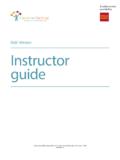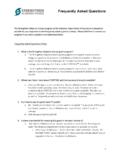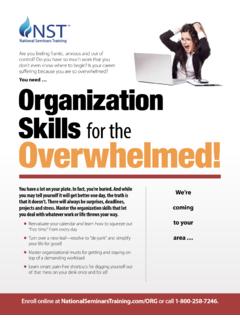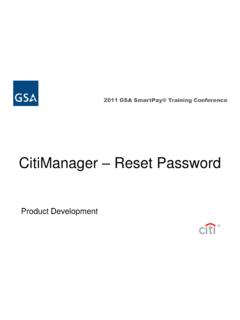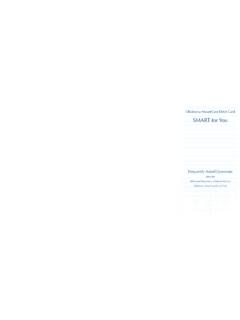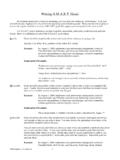Transcription of Teens' Instructor Guide - Hands on Banking®
1 Instructor guideTeens version 2003, 2012 Wells Fargo Bank, All rights reserved. Member FDIC. ECG-714394 Hands on Banking Instructor s Guide teens Version (Grades 6 8) Table of Contents Introduction .. 3 How to Use This Guide .. 5 You and Your Money .. 8 Section 1: Money and Banking ..10 Section 2: Value ..14 Section 3: Earning Power ..17 Teaching Tips ..18 Budgeting .. 20 Section 1: Understanding and Creating Budgets ..21 Section 2: Using a Budget ..31 Teaching Tips ..40 Savings and Checking Guide .. 42 Section 1: Savings Accounts ..44 Section 2: Checking Accounts ..62 Section 3: Balancing a Bank Account ..66 Teaching Tips ..71 Credit and You .. 74 Section 1: Credit and Credit Cards ..75 Section 2: Loans ..80 Teaching Tips ..81 Smart Investing .. 82 Section 1: Introduction to Investing ..83 Section 2: Capital Gains and Losses.
2 87 Teaching Tips ..90 Assessment .. 91 Additional Student Activities .. 96 Additional Financial Literacy References for teens * .. 107 Glossary .. 109 Hands on Banking Certificate .. 115 Hands ON BANKING TEACHERS Guide 2003, 2012 Wells Fargo Bank, All rights reserved. Member FDIC teens INTRODUCTION 3 Introduction The Hands on Banking program is an interactive financial-literacy curriculum for students grades 4-12 and adults. This teacher s Guide is designed for the teens (grades 6 to 8) curriculum of the program. The Hands on Banking program was developed to teach both the basics of good money management and the skills needed to create a brighter financial future. The lessons examine financial concepts and decision-making through illustration, real-life problems, and mathematical computation. The curriculum is relevant to students lives, and is designed to support their financial success.
3 This fun and innovative program was developed by Wells Fargo as a free community service. It is intended for educational purposes only and contains no commercial content. The Hands on Banking program is available free of charge in both English and Spanish, both on the Web (at and ) and on CD-ROM. The curriculum is designed for both self-paced, individual learning or for classroom use. This teacher s Guide is designed to be used alone or as an adjunct to the online program. Educational standards The lessons in this program adhere to the following mathematics and financial literacy and standards: National Council of Teachers of Mathematics (Principles and Standards for School Mathematics, 2000) National Council of Economic Education and the National Association of Economics Educators and the Foundation for Teaching Economics, Voluntary National Content Standards in Economics (1997) JumpStart Coalition for Personal Financial Literacy, National Standards in K-12 Personal Finance Education (2007) Teachers are encouraged to integrate the content into other lesson plans, and use the curriculum as a springboard to address real-life situations.
4 Please refer to your own state, local, district, or school standards to determine the appropriateness of the lessons for your students. The No Child Left Behind Act is a federal law designed to improve the academic achievement of all students, particularly those who are minorities, disabled, economically disadvantaged, or have limited English proficiency. The Act requires teachers of mathematics to provide all students with equal opportunities to excel and the mathematical skills and knowledge they need to actively participate in American society. Consistent with the objectives of the No Child Left Behind Act, the Hands on Banking / El futuro en tus manos curriculum and supplemental materials for grade levels 4-12 are aligned with both state and national educational standards for mathematics, reading, and economics. Curriculum overview The online teens Hands on Banking curriculum is divided into five units, plus an assessment.
5 Each unit contains multiple lessons. The teacher s Guide condenses each online unit s lessons into a smaller number of sections. The lessons in this Guide contain activity worksheets for you to use with your students. This curriculum is designed to be presented in the given lesson sequence. However, depending on what is appropriate for your students, you may wish to establish your own sequence. Problem solving is woven into all of the program s units. Students apply both their understanding of basic banking concepts as well as strategies to solve challenging problems in different contexts. Hands ON BANKING TEACHERS Guide 2003, 2012 Wells Fargo Bank, All rights reserved. Member FDIC teens INTRODUCTION 4 To be successful with the Hands on Banking curriculum, students should be able to: Perform basic functions on a calculator Read proficiently at a level commensurate with their grade level Follow basic written and oral directions, and readily understand oral dialogue Because students mathematical skills vary, teachers should review the problems in this Guide before having students use the Hands on Banking Web site.
6 To request a free CD-ROM To request a CD-ROM for your classroom, please contact us via email at The CD-ROM contains both the English and Spanish versions of the program for all age groups. There is no charge for small quantities of the CD-ROM. Please call for information regarding high-volume requests. Please allow two weeks for delivery. Your thoughts are welcome We welcome your comments and suggestions for future versions of the Hands on Banking curriculum and this teacher s Guide . Please contact us via email at Thank you for sharing these valuable financial literacy programs with students and adults in our communities. As a teacher, your training and guidance will provide others with the knowledge and skills they need for a brighter financial future! Hands ON BANKING TEACHERS Guide 5 2003, 2012 Wells Fargo Bank, All rights reserved.
7 Member FDIC teens HOW TO USE THIS Guide How to Use This Guide The purpose of this teacher s Guide is to support the effective presentation of the Hands on Banking curriculum in your classroom. As a first step, we strongly encourage you to review the program online (at and ). Even if your students will not be using computers at school, gaining familiarity with the program will help you present it more effectively. Five ways this Guide can help you This teacher s Guide is designed to be used alone or as an adjunct to the online program. if you re a teacher or group leader, this Guide can help you in five ways: 1. Gain familiarity with the program: Reviewing this Guide is a convenient way to familiarize yourself with the teens curriculum if you do not have ready access to a computer or the Internet. 2. Prepare lessons: If your students will not have access to computers, you can use this teacher s Guide as a resource for preparing your lesson plan.
8 3. Utilize worksheets: The teacher s Guide includes activity worksheets which allow your students to apply what they have just learned to real-life scenarios. A teacher s copy of each worksheet, including answers and hints, follows the students worksheet. 4. Extend or modify lessons: The Guide features suggested teaching tips. Use these additional activities to extend or modify the unit objectives to best meet the needs of your students. 5. Assess progress: Finally, this Guide includes an assessment that students can use to test their knowledge. How the Guide is organized This Guide covers five units, followed by an assessment and a dictionary of financial terms. The Hands on Banking curriculum is designed to be presented in unit and lesson sequence. However, depending on what is appropriate for your students, you may use this Guide to establish your own sequence.
9 You may choose to present individual units or lessons on a stand-alone basis, or in different combinations, based on your specific educational objectives. Each unit of this Guide adheres to the following format: Unit Overview A summary of the unit s content. Learning Objectives The specific financial-literacy and mathematical objectives of the lessons. Alignment with Educational Objectives The financial-literacy and mathematics standards, by grade level, to which these lessons are aligned. Sections A grouping of related Hands on Banking lessons. Each individual section includes: Opening Questions Questions to start your students thinking about the concept and how it relates to them. Key Points A series of bullet points summarizing critical concepts. Please note that this portion of the Guide frequently includes extra information to complement and enrich what is offered in the online version of the Hands on Banking program.
10 Activities Indicates that a worksheet follows. Student Worksheet These worksheets allow your students to apply what they have just learned to real-life scenarios. Hands ON BANKING TEACHERS Guide 6 2003, 2012 Wells Fargo Bank, All rights reserved. Member FDIC teens HOW TO USE THIS Guide Teacher s Copy of Worksheet A teacher s copy of each worksheet, including answers and hints, follows the students worksheet. The students copy can be duplicated or made into an overhead transparency for a whole-class activity. Teaching Tips Use these additional activities to extend or modify the unit objectives to best meet the needs of your students. About content modifications Please note that in some cases the content of the teacher s Guide has been modified from the online/CD-ROM program. (For example, the online lesson may ask students to use a calculator, ATM simulator, or computerized worksheet features that are available to only those students using a computer.)

